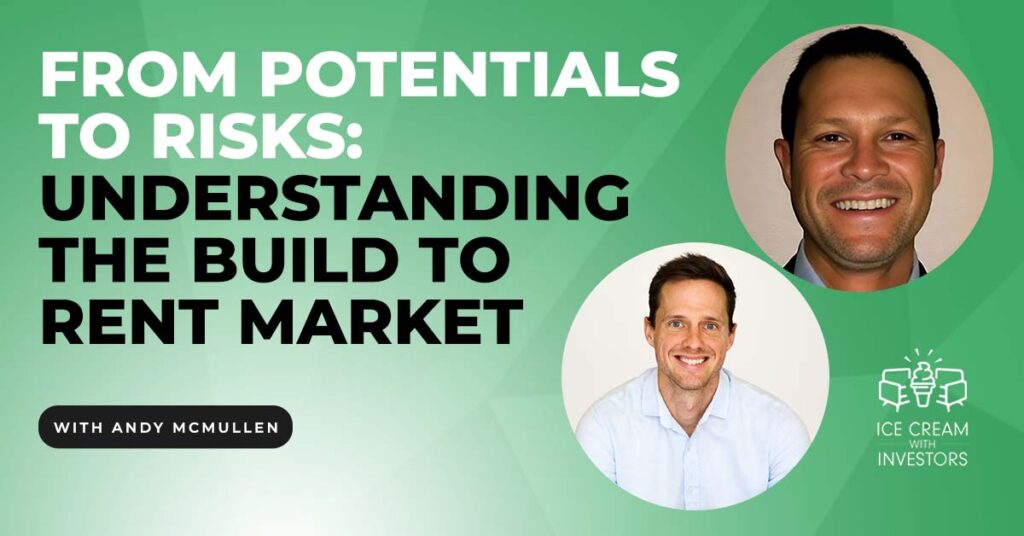The Build to Rent sector is still in its early years, and yet more and more people want to get involved. What can you gain from jumping into this space? Why is this attracting a very specific niche? And most importantly, what are the risks? Together with Andy McMullen, Managing Partner at Legacy Acquisitions, this episode takes a deep dive into Build to Rent and everything you need to know about investing in this market. Tune in and learn if this is the right investment to put your money into!
—
Watch the episode here
Listen to the podcast here
From Potentials To Risks: Understanding The Build To Rent Market With Andy McMullen
On this show, we have Andy McMullen with Legacy Acquisitions. Andy’s been involved in real estate for many years. I was super excited to have him on the show to not only talk us through some of his background and mistakes he learned along the way but also his newest initiative, which is developing build-to-rent models throughout the United States. As we continue to see home affordability being an issue across the United States, build-to-rent satisfies a unique niche in the real estate space. Read this episode to learn more about build-to-rent, how it fits and some of the markets that Andy is developing in.
—
Andy, welcome to the show.
Matt, thanks for having me. It’s my honor to be here. I appreciate it.
We like to start with the difficult questions here. What’s your favorite ice cream?
I’m curious if you ever got chocolate malted crunch.
I have not. What is that deliciousness?
I remember going to Thrifty as a kid. That’s how old I am. For $0.15 or $0.25, I scooped those up. My dad when he was a kid, worked at Thrifty. He’d let me scoop it up.
Is it an ice cream store?
Yes. It is now Rite Aid’s bottom. I think they still have the chocolate malted crunch. I’m curious if you ever had anybody say, “No, I don’t like ice cream?”
I did. We ended the interview immediately.
I was talking to my daughter and she’s telling me she doesn’t like Bluey. I said, “That’s like saying you don’t like ice cream, apple pie or Taylor Swift.”
Tell our readers what’s the scoop. What do you do?
What we’ve been focused on is working on build-to-rent. We’ve been developing a lot of single-family projects in large 100 to 300-unit ranges and then managing them as horizontal multifamily. My background has been in development and multifamily. It makes much sense with the economy, interest rates, lack of supply and Wall Street’s desire for yield that this came together. We have a couple of partners in the Southeast and we’re working on our 3rd or 4th project. It’s exciting. That’s probably the thing I’m most passionate about helping investors consider because it’s tough to find some of those other deals that we’ve been doing over the last couple of years.
I’m super excited to talk about build-to-rent because you’re the first person I’ve had on the show to talk about it and it is a phenomenal trend going through the marketplace. Before we get there, you’ve been in real estate for a very long time. Can you take us back to where your real estate journey began?
It’s a very long time. I started in the brokerage, working in LA, Marina del Rey’s little office. It’s like a boutique firm. I did a lot of investing in industrial projects and office buildings then I would handle a lot of the brokerage stuff. We evolved into other types of deals. I got into development. I tell people, “If you stay in long enough, even a dummy like me can go your way through.” I remember sitting in the car in my 2nd or 3rd year. I’ve been doing other referee jobs. I was delivering auto traders. I was like, “I’d come after work and I’d be doing telemarketing calls for the Disney concert hall. “
If you stay long enough in your chosen path, even a dummy can make their way through.CLICK TO TWEET
Whatever it took because, in brokerage, there’s nothing. After the draw comes off, you erase it, you and in my case, my hoopty car and whatever my resources could be. What I tell people that work with me on our team is that for those first 3 or 5 years, it sucks. Maybe you’ll collect a few fees but until you can turn deals into more deals and build without paying the taxes, then it takes a while. I always hear people say, “Real estate is way more fun than I thought but also way harder than I thought.” That’s part of it because there is this slow climb.
I appreciate the humility you came around saying that even a guy like you but I’ve done some research. You’re an Econ grad from UCLA. You’re no schmuck over.
If they don’t give those degrees the same way, I don’t think I would’ve gotten into this.
I’ve got a sales background and I’m always interested in how folks with a greenfield sales opportunity, meaning you’re not working for a big corporation where you’re given a set account to manage. How do you find leads and develop your business? Could you take us back to those days? How did you do it back then?
When I hear people talk about raising money before the JOBS Act, which is what we had to do before you had these opportunities to create your funnels and 506(c)s and you could advertise, it was straight cold calling. People don’t believe me when I say that because they think that never works in how you stay in a business. For me to find deals and us to find investors, we had to do a lot of calling, a lot of follow-up emails too and trying to set up face-to-face but the old school way.

Build To Rent: To find deals or investors, you have to do a lot of phone calls, follow up emails, and even face-to-face meetings the old-school way.
If you were to be reductive about it, it is about those hundred people that you invest your time into continuing to add value and following up. What I started to figure out is the 80/20 idea, capital raising, finding deals or real estate. There is so much white noise. Most entrepreneurs and all of us that are reading this recognize a part of us that is like, “There’s a shiny object.” With finding deals and raising capital, there’s got to be a focus and for me, ultimately building out a team so they can keep me from screwing up and getting in my way.
Many people get sucked into, “I want to be everything to everybody.” When in reality, what you should do is go find a niche. If you can find 100%, you can build a dang good business no matter what business you’re in if you focus on those 100 people.
Mitch Hedberg, an old comedian, would talk about I would go down the aisle at the grocery store and see honey, mesquite or smoked Turkey. He’s like, “Why can’t you be yourself Turkey?” Instead of focusing on all these different things, be yourself and figure out what it is that you are good at. Especially in real estate, it’s in investments. For a lot of people that you’ve had on the show, all of these things are team-oriented businesses. If you do it all, you’ll drop all the plates.
To put a bow on this conversation, Brandon Turner, who used to host the BiggerPockets Podcast, posted something on social media that said, “All real estate works in all markets. You have to decide which niche you want to focus on because if you try to do all of the real estate then that’s a sure path to failure. All real estate works. You have to figure out what works in your market.”
It’s even more apparent that we’re starting to see real estate even become more localized. In 2008, the music stopped for everybody. We were doing development. Nationally, there was nobody getting deals done almost until 2012. In 2022, you’re starting to see there are markets that are ascending and descending maybe that we thought were a favored son. You’ve got much more opportunities to look at either your backyard or some of these obscure markets where you can niche down and become that expert in that particular space.

Build To Rent: You have many more opportunities to look in, either in your backyard or some obscure markets, where you can niche down and become an expert in a particular space.
Let me ask you about 2008. We’re at the back half of 2022. 2023 is going to be a very choppy year for a lot of people. Specifically, if you’re dependent on the low cost of capital, which real estate, typically over the past years has. Can you talk us through what was your experience in 2008? What did you do to navigate through that?
Sometimes I look back and wonder how we did because you are going to think back. We’re finishing up development in Venice. It is what we were working on. I’m a lower man on the deal team but we’re junior partners. We’re trying to put all the resources together. I remember every single day from 2008 to almost 2011. We were on the phones with other banks like McFarland, whether you come in and take a piece, private lenders, walk in the project or, “Is there another private investor that we can consider?”
We are talking about an incredible location and knew the asset was going to be coming back but we had pre-sold, let’s say, $700 a door. Now they’re $1,500 door. 2008 hits, they’re automatically coming down to $400 a door. You’re re-trading almost your entire project. This is a live-work space. I remember the overall malaise. At that point, if you would’ve asked me, I would’ve said I was a Christian but I probably wasn’t walking that close to him. I remember that it was a struggle for everybody.
If there is a note to take from that and what we’re dealing with is that you ultimately are as strong as your relationships. You have an opportunity to serve people at this point because everybody needed something. Everybody needed either a deal, an opportunity, money or an investor. That would be a takeaway. I do think it’s going to be a choppy year. There’s no doubt.
You are as strong as your relationships. You always have an opportunity to serve people because everybody needs something.CLICK TO TWEET
I do think it’s a little bit different in the sense that we weren’t oversupplied like we were in 2008. There is a lot of equity in a lot of people’s homes. A lot of people are locked in at that kind of 2% and 3% mortgage rate. Part of the reason we like the build-to-rent idea is that it does fall into what we call a triangle which is the high rents, the low supply then we’ve got the affordability gap, which is growing. Mortgage payments are about $850 to $900 more than the rental payment, which brings everybody to these development opportunities.
I like this idea of when times are tough, your ability to serve and help others is what’s going to help you navigate through this. The build-to-rent model is very interesting. I want to take a step back for a second. Can you help our readers understand? If build-to-rent is a new term for them, what is build-to-rent? We’ll then take it from there.
If you think about build-to-rent, it’s been going on forever. Let’s take it back to 2008. I do remember when my partner who passed on, my mentor and a beautiful man, Bob Delia, started going to some of these auctions in 2008 and 2009. All these homes are being bought up by the Blackstones of the world and they’re buying them for 50% on $0.50 on the dollar but they’re across counties. There are no efficiencies at all. They’re trying to figure out, “I can buy $1,000 in 10, 12 or 14 different markets. I’ll figure out how to manage them.”
It wasn’t very efficient. Those guys made a lot of money eventually as appreciation came up and cashflow and rents started to rise. They started figuring out American homes and BlackRock came back in the game, “Why don’t we build these properties in one community, managed them as we would multifamily projects? We’ll have the clubhouse and the pool. We’ll have big backyards.” That was a big draw backyard and a doggy door.
We can manage them like pulled-apart multifamily or horizontal multifamily but we don’t have our managers driving from county to county to try and manage them. It’s been going on. As far as the development in the sense that you’ve got Wall Street that needed yield if they’ve got their pension funds, CalPERS or CalSTRS, they can create that yield by the increasing rents. For a time, they were getting some run-up on the appreciation, which we might see regulate back down.
What it turned into is the suburbanization that has been going on even before COVID. You go to the secondary and tertiary markets where they’re like, “Give me a good elementary school, eight or above. Give me some amenities that are there. Give me a community where I’m renting and not stigmatized for being the only 1 or 2 renters in the area. Give me a dog park and I’m loving this.” That’s what’s been happening.
Most of our residents happen to be younger families, either couples or couples with young kids. That’s probably about 60%. There are a lot of empty nesters that are saying, “I love the idea of my barbecue in my backyard. I don’t want to do anything more than change a light bulb.” They’re the other class of residents that we have coming to our project. You’ve seen it anywhere from a very simple build-out. One of our projects has parks, big backyards and walking trails but no pool or clubhouse. We still rent in Lafayette, Louisiana for $1,700 a month. There’s a lot of demand for that type of asset.
I want to try to summarize where I see the market and build-to-rent. As a guy that’s in this space all the time, I would love to know your perspective on it. In my opinion, two real trends are going on here. The first one is affordability. It is mainly driven by the lack of supply. In 2008, we oversupplied the market because everybody had a 2nd and 3rd home that they got cheap debt on an adjustable rate that they could rent out themselves or keep as a “vacation home.” Ninja loans cause a lot of that. You have an affordability crisis driven mainly by supply.
The second thing you see is this whole class, we’ll call them Millennials but at the older end of the spectrum, it’s the same thing where they’re by nature more transient. I don’t mean transient in a bad thing. It means that at times in their life, they want to live in Miami, New York or somewhere else. The best way to do that is to rent. However, a Millennial class is also coming to the age where they are having two and a half kids and a dog and they want a white picket space fence. They want a room to work from home, work out from home and have a family as well. The build-to-rent model is attacking both of those ongoing trends in an effective way.
The other thing that I would add to it is that we’re in the very early innings of it. If you think about Wall Street, the amount of real estate they own in the multifamily space is about 50% of it. They only have about 2% to 5%, depending on which statistic you’re looking at. When you consider that and you hear a lot of people say, “They’re just bumping up the prices.” They own such a small amount of homes and there’s a lot of money being poured into the development.
Certainly, in the next years, we’re talking about billions. We’re still in the early stages because people are figuring out, “I could rent something with all the new tech. I can live here for a couple of years and commute to my work. I’m working from home and not messing with the traffic. I’ve got the barbecue and the dogs.” It’s starting to make sense for a lot of people. Even before COVID, we started to see it. It was accelerated after the pandemic.
I want to shift this to markets. Build-to-rent, you’re building out communities of single-family homes that you ultimately keep and rent out in a portfolio. What markets are you looking at for this specific type of strategy? You mentioned something around 100,000 or 300,000 people but are there specific markets you’re looking at here?
For us, it’s the Southeast. What we want to see is whether we can get the land inexpensively enough. The Southeast still has some great areas where you can get the land inexpensively enough. The impact fees are lower. You’ve got mayors and municipalities that are much more development friendly. The speed with which you can build these projects is crucial in development. We like the Southeast. One of our partners is in Lafayette, Louisiana. We like Baldwin County, Alabama, which is another fast-growing area.
It’s the fastest in Alabama and you’d be amazed at what’s happening there. We’re looking at Chattanooga, Tennessee and the Carolina. We like the Southeast. The area that we feel most confident about is if you are talking to a lender, you want to have a decent enough yield on cost. I don’t want to bore the audience but it is helpful to understand when you’re looking at a development project, whether it makes sense or not.

Build To Rent: If you’re talking to a lender, you want a decent enough yield on cost.
If you’re considering what that stabilized income is going to be, after you’ve built up the project and you put all your costs, what is that net income that you’re going to receive divided by the total cost? Let me give you an example. Let’s say that your net income is somewhere in that $1 million or $4 million range and your total cost for the project was in that maybe $5 million for the land and $15 million for the build. That’s $20 million. It’s somewhere in that 7% range or something like that.
With that yield on cost, most lenders want to see maybe six and above, depending on the market. The reason that they care about that is that they care about what the spread is. The spread is what’s the difference between the yield on cost and the cap rate. If you got a cap rate that’s somewhere in the 5% range and a yield on cost that’s in the 7%, you got a 200 basis point spread. That’s a good safety net.
Why that’s important to developers and investors who are in development is because those two numbers help us create what we call development lift, which is what’s the total value that we’ve created by putting that amount of money into the project, cost of the real estate itself, the land and everything in between and what is against the cap rate.
7% minus 5% is 200 basis points. Divide that by the cap rate, that’s 40%. We’ve created 40% value by putting that money in and building out this income stream. If we can’t get that 6% and we start seeing cap rates come up and land costs still come up, then there’s not a whole lot of spread. 1) You’re not going to get your loan. 2) You’re going to be close to underwater. We haven’t been able to see those yields on cost anywhere else Southeast. I hope that’s helpful. We talk a lot here on cashflow and IRR but when you’re looking at development projects, you want to consider what is that yield.
I’m glad you explained that to me. I will go back and re-read this. I’ve heard this concept of yield to cost a lot, specifically in the value ad space, not in the development space around like, “You can bump up rents, increase your NOI and all that sort of stuff but what is it ultimately going to cost you to get it there?” What you’re saying is if you can get a yield on cost of 7% but in assets trading at a 5% cap, you’ve created that extra 200 basis points of goodness or what you call the developer lift. This is impactful for me.
If you took that 2% and divide it by what the cap rate is, you could tell how much value you’ve created. In that case, that’s 40%. That’s the big deal. If it takes you 48 months here in San Diego where I’m located to try and build out a project like that and you got a deal with everybody in California that hates anybody that’s trying to do something, that doesn’t matter whatever your stabilized income is because the time was too long.
That’s where we feel like if we’ve got a relationship with the mayor and the community and they love the green and what we’re building there, which is a little bit different than multifamily, you get your COO after it’s done. With our projects, we can build 1 unit, get the COO or Certificate of Occupancy and then lease it up. If the lending rates become crazy, you have to pull the ranges a little bit, then we can stop building and collect the income. We’re not a half-built project that’s in the middle of their community.
That’s a super interesting epiphany. In the build-to-rent model versus multifamily, what I’m hearing is like, “Once you finish a house, you can lease it up and start getting income streams coming in. All of a sudden, that helps you balance out your cashflows.” Development is very tranche. You’re pulling money in a tranche fashion, which means you get a big lump sum of money and you can’t pull the next lump sum of money until you meet certain milestones. In this case, not only you’re pulling the next sum of money but you’re also getting income streams coming in.
That’s part of the reason we love it. With rates where they are, we signed our loan. I had the notary and then the next day they decided to drop the LTC from where we were at 80 to 75. What that means is we got to come up with another $1 million or so, a little bit safer deal for the investors if it worked out okay. This is one of the top lenders in the country. You can imagine where we started because usually those loans are set up on a spread plus SOFR which is the short-term rate.
We started working on this project, the SOFR was 20, 30 or 40 basis points and now it’s at above 300. You can imagine if you didn’t have a pretty significant rate cap, you could watch your projects going down. A lot of multifamily owners and people got in trouble because no one could foresee that. If you got a 3.5%, you decided it was too expensive by the rate cap and you are struggling a little bit. What we want to do at every project that we underwrite, we want to make sure that we can carry that even at the higher interest rate if we had to all the way through for 4 or 5 years with the expectation that they didn’t come down without refinancing.

Build To Rent: If you didn’t have a pretty significant rate cap, you could watch your projects going down. Many multifamily owners get into trouble because no one can foresee that.
We want to make sure that’s part of the reason why spread and yields are important because we know what our investors are thinking. They’re like, “Do I want to get into development if the rates are high and no one knows what’s happened with the market?” Instead of being those guys that want to advertise higher IRR and great upside potential, you need to be what are the risk litigants. What’s the worst-case scenario? That’s a little bit different from the game that we’re playing.
Your build-to-rent strategy is a little bit different than most development projects in the sense that you already know what the established rents are in that market. I’m assuming your underwriting is based on current market conditions, maybe minus ten points versus the traditional, “We’re going to raise rents,” and things like that. What I’m saying is when you’re doing a traditional multifamily development, you’re not even seeing that income or you’re dependent on the asset value. If you’ll trade that at that given time, you’re going to hold these assets and rent them out. You’re in a more conservative underwriting model in the general nature of the strategy.
When you think about it, maybe there are some cashflow deals. I haven’t seen many since rates are up at the 6% or 7%. That Delta is not there. For instance, in Lafayette, we already built some of them so we know our rent is at $1,700. If we can underwrite that we’re not going to go above 3% per year, which is unlikely and we’ll probably be able to beat that, then there’s some safety there. If we can have a contingency that’s 10% or 15% when most people have 5%, then investors start to get a little bit more comfortable.
We’ve got to exit cap rate that’s over 100 basis points or whatever that number is. We try to put in these guardrails. As an investor, I’d much rather see these 15 or 16 IRRs with a lot of risk litigants than care to see those high 20-plus in whatever the deal is if you consider the rates that a lot of that has been sucked out of it.
You’ve mentioned Lafayette and Chattanooga. I know enough about those markets to say that both of them are very heavy rental markets. Where’s Baldwin County, Alabama?
The project that we’re looking at is Foley, Alabama, which is a Southern part of the Gulf. For us to get to Lafayette, we’re going to New Orleans. Lafayette is about two hours away and then we’re going back through that area. Foley is another four hours from Lafayette. They’re all in that range. We’re looking at something in Austin. Austin is a different animal because it’s a moving target. In some of these markets that we’re working on, we have a clearer understanding of what’s the trajectory. Those are the markets that we’re looking at. There’s Greenville in South Carolina. There are a good couple of spots like that.
There are many of these markets that make sense. You might have one community that didn’t have a sewage system. Maybe you’re having not as much water. In North Carolina, there are a lot of communities over in 2021 but the water’s running through it. No more septic tanks. Everything’s coming with the infrastructure surrounding them and you could still pick up the land relatively expensive. If you’re going to look at it, in respect of the markets, it’s the topography. We don’t want to pay a lot on land or tree clearing and that kind of thing.
The schools are big deal for us. Also, you can consider crime reduction because that’s usually where people want to go. The normal population and economic growth are all important. Those used to be only in secondary markets. In 2022, you’re starting to see them even in tertiary markets or even further out in the suburbs.
I started the show by saying that you’ve been in real estate for a long time. One of the things that I’m starting to ask a lot of people for is their thoughts on 2023. We’ve alluded to both of us thinking it’s going to be a choppy time. I want you to take off your developer hat for a second and put on your investor hat. What should our normal accredit investors be thinking about as they enter 2023 here?
You’re going to have to be disciplined. You’ve got a lot of different kinds of investors that are reading this show. We read some great ones on capital preservation, tax strategy and all of that. What I remember about that time was patience is tough. When you think about 2008 and then it didn’t come back until 2011 and 2012, there are 365 days in each of those years that I’m like, “Let’s have it.” You got to be disciplined. To me, it’s much more important that you’re betting on a team that’s got the track record and the liquidity in net worth to be able to sustain maybe what’s happening.
There have probably been some great opportunities over the last years, even with younger teams that have done fantastic, very capable and talented acts. The second piece of that where there’s the liquidity and net worth to sustain being able to get loans and refinance are tough. Investors need to be a lot more realistic on a lower income or cashflow deal with more consideration on, “What is their exit cap? What are they projecting for their rent increases? How much contingency do they have in the bank?” I would look a little bit more at the comps because that’s where a lot of people are able to fudge the numbers. Make sure that you’re looking at the comps and if are they below what that market is because you don’t want to be the highest comp. You want to be lower. I would look at those factors.
I’m glad you mentioned comps but I’m not going to breeze over the fact that you said liquidity. Over the past years, we’ve all been a little lazy on the fact that money has been a very plentiful supply and easy to grab. I’ve been trying to tell a couple of my friends in my network, “You need to have access to cash. You don’t need cash in the bank.” The strategy in the past years has been like, “Get the cash off your balance sheet. Put in assets. It’s going up fast that you don’t want to have it sitting on that balance sheet.”
I’m not saying you have to have it in your savings account but you need to have access to cash. I don’t know if you’re following what’s going on with FTX and Binance. You want to talk about liquidity being king. The largest crypto exchange in the world got knocked out in a matter of 72 hours because of a liquidity crunch.
I was looking at Twitter. People tried to sell for $0.93 on the dollar. Imagine, they never made that deal so it goes down to $0.50. We’re talking about zip. I was on a lot of shows in 2021 and I’m guilty of saying, “You got to get the equity out of your house. Put that cash in cash-producing assets because you don’t want that on your balance sheet. Put that on the bank balance sheet. Why are you sitting on that with inflation? It’s going to blow up.” With where we are, you’ve got to have access, whether that’s a KP on your team or collateralizing some of your other assets. Whatever that is, you have no idea what’s going to happen.
You need to protect yourself. With each kind of phase for the development, we want to make sure when the horizontal’s done, we’re like, “Here’s where the value is.” When the infrastructure’s all done, we can move on to the vertical. Where do we sit there and how would each step can we cash out or refinance that helps us secure? We got to be set up or we may not ever have that opportunity. If you don’t have the access to capital and cash to keep the property with not refinancing, as an investor, you got to consider whether that’s the right team that you want to ride with.
I want to switch us into our last round. We’re calling this The Five Toppings. Our first one is, what is your favorite book or what is a book you’ve read that’s given you a paradigm shift?
Have you read The Hard Thing About Hard Things?
No, but I’ve heard about it several times.
To me, that was a game changer for the reason that we’re all running a business and most books are written about, “Don’t do this or that.” His book was written like, “I already broke my business. Here’s how we fix it.” We have a version of that where we are solopreneurs, we’ve got a small team or a larger team and that would change the way that I look at the evolution of growth. The same people that you’ve got to help get to one spot might not be in the right seats when you get to the next stage. The same kind of thoughts that you have at that stage will not get you to the place that you need to go at the next one.
The same people you helped get to one spot in your business might not be in the right seats. This will make it hard for you to get to your next stage.CLICK TO TWEET
I’m going to have to put that on the reading list because that keeps getting recommended to me. Our second one is, I believe the person you become ten years from 2022 is directly correlated to the habits that you have and the things you do every day. What are some of the habits that you have?
I’m a big Hal Elrod guy, The Miracle Morning. For me, the most important part of it is journaling in the morning where I can write all the chaff away. How many ever thoughts do we have? Eighty percent of them are negative. If I can get all that stuff out of my head, then I can start to focus on the things that I want to achieve that day. Usually, it’s three. The journal’s got to be first, then I’ll read and do the workout. I try to do that every day.
Around 80% of our thoughts are negative. If you can get all that stuff out of your head, you can focus on the things you want to achieve.CLICK TO TWEET
My affirmations sound similar to yours with the Bible. I’m reading seven which is an interesting book about the seven letters of revelation from Jesus. It is cool to see from a practical vantage point, how did each of these churches act? What was their culture like? It was fascinating. I tell people real estate always is much slower than you think and then there’s one day when it’s so much faster than you think. Can you stay in the game long enough to hopefully get that tailwind?
I’m glad you said the journaling piece. When I first heard about that, I thought it was very fluffy and fufu, then I realized when I started doing the activity, how many negative thoughts were bearing down on my mind that I could release, get out and start the day fresh.
It’s crazy how it eases. It gets on the page. I use Evernote and then it’s out so I focus on the other stuff.
Our third one is what’s the best piece of advice you’ve ever received?
It’s the version of what I told you about being yourself. I do think people sometimes over-consider an expert’s view without considering or trusting their nuance and what they’ve learned. Go to any expert who wants to have an answer for you. He might have some of the facts that you do but you think that because he’s been doing it for 20 or 30 years, he’s got all the answers. Usually what I find is the only thing that you can do to solve a problem is it starts from here and then it comes into focus. You are the only one that understands that nuance.
Way earlier in my career, I trusted all these experts and kept being frustrated by, “Why are these guys smart? They seem like idiots,” but they didn’t have the information that I did. I try to tell my team, “If there’s one gift I can give you, it is if a dope like me can do it, then you guys can do it.” They’ve got all the resources that they need to figure out the answers to the questions and certainly, we talk about them. That’s the piece that sticks with me.
Our fourth one is, what’s the thing you’re most proud of in your life?
Family, but one thing that I’m getting a lot of pride in is our church community. I’m doing a lot of work with the young teens and some of the young kids at Sunday school. More than a Sunday, it’s weekly. It’s like a teacher gets many rewards from their students and you always hear about people about students like myself going back and talking with old teachers. That part of the coaching and teaching for my life had been stagnant for a little while. That’s what I’m getting the most pride in.
Isn’t it fun to see somebody that you see their potential they don’t so you can guide them to it and then they finally get there?
I don’t know if there’s a better light going on. If you think maybe for eight months, I don’t even know if they’re hearing the word I’m saying. Them asking a question that I talked about is fantastic. I think about my life too. I was always in sports. With the coaches and mentors that I had, I don’t know if they thought they were getting through but like God’s thoughts, I still have golf thoughts from whatever coach was telling me.
Our last one is if you could sit down and eat a bowl of ice cream with anyone dead or alive, who would it be and why?
With my faith, I would love to be sitting down with Jesus but one of your guys said Paul at one point. I’m fascinated with people who have built their empires from very little. I think of Stephen Schwarzman if you recognize him from BlackRock or Mark Cuban, billionaires that have this money but are doing good with it. I would love to probably talk with one of those guys. The idea of kingdom wealth, which is our why is, “How many of these communities can we bless? This money that we’ve got doesn’t belong to us. It belongs to him. Can we be the best steward of it?” I would love to be in that situation. I think about that guy who won $2 billion. I want to know who is that guy. You can’t spend $2 billion. What kind of communities can you invest in that? That’s amazing. I want to talk to that guy.
I said the same thing because we did an icebreaker at work and everybody said, “What would you do with the $2 billion?” I said, “First and foremost, there’s no way you could physically spend $2 billion.” Maybe you could. You have to have some passion or good that you could get back with that. It was an interesting thought exercise.
Think about the story of Bill Gates trying to figure out how you get water to these places and how much money it cost. I’ve got kids. One is very self-centered. I’m sure she’s going to grow out of it but when you think about this huge world that we live in and take that $2 billion in 1 specific problem like that, imagine the difference that you could make in the world. I love talking with you. I appreciate you having me on.
If our readers wanted to reach out to you and learn more about you, the build-to-rent communities that you’re building or anything else that you got going on, where’s the best place we could point them?
It’s on our website, LegacyAcquisitions.com. We’ve got a lot of resources there. They can get in touch with me on LinkedIn as well.
Andy, thanks for coming to the show.
Thank you. I appreciate it.
Important Links
About Andy McMullen

Andy is a Managing Partner at Legacy Acquisitions which is focused on partnering with the world class operators. Andy values his long-standing personal relationships with brokers, operators, institutional lenders, private equity firms, and has orchestrated over $750 Million in commercial real estate transactions over a 20 year career.






